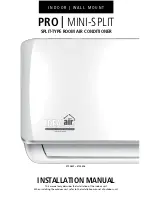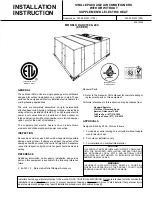
• Installation procedure
• VRV
®
Systems • Installation procedure
10
1
Installation of outdoor
1 - 6 Handling of the plate type heat exchanger
1 - 6 - 3
Daily service and maintenance
1
Management of water quality
The plate type heat exchanger has a structure that does not permit dismantling and cleaning, or replacing any parts. Please pay attention carefully
to the quality of water to be used for the plate type heat exchanger in order to prevent corrosion and sticking of scale.
The water to be used for the plate type heat exchanger should have at least the quality as specified in the table below.
When using any corrosion prevention agent, scale depressant agent, etc. such agent should have no corrosive features against stainless steel
and copper.
2
Management of chilled water flow rate
If the chilled water flow rate is not enough, it will result in the freezing damage to the plate type heat exchanger.
Check for any clogging of the strainer, any air being caught, any reduction in the flow rate due to failure of circulation pump by measuring the
temperature and pressure differences at the inlet and outlet ports of the plate type heat exchanger. If the aged difference in the temperature or
pressure has increased beyond the proper range, the flow rate should have decreased. Stop the operation and remove the cause before restarting
the operation.
3
Steps to be taken when a freezing protection device was activated
When the freezing protection device should be activated during operation, remove the cause without fail before restarting the operation. If the
freezing protection device has been once activated, a partial freezing has occurred. If you restart the operation without removing the cause, the
plate type heat exchanger will be closed and the ice cannot be melted, and in addition, the freezing process will be repeated resulting in any
damage to the plate type heat exchanger, leading to any such accidents that the refrigerant starts leaking or water starts entering the refrigerant
circuit.
1 - 6 - 4
Water quality
Water quality standards for chilled water, hot water and make-up water (4) (6)
N
OTES
1
The circle marks in the columns for corrosion or scale to develop.
2
Corrosion has a tendency to occur when water temperature is high (40°C or higher), and if metals with no protective coating whatever are directly
exposed to water, it would be a good idea to take effective measures against corrosion such as adding a corrosion inhibitor or deaeration treatment.
3
In a condenser water circuit that uses a closed cooling tower, the closed circuit circulating water and make-up water must satisfy its water quality
standards for the hot water system, and passing water and make-up water must satisfy those for the circulation type cooling water system.
4
Supply or make-up water should be tap water (clean water), industrial water and underground water except for purified water, neutral water and
softened water or the like.
5
The fifteen items in the table above represent typical causes of corrosion and scale.
6
Passing water may cause corrosion.
Do not use passing water.
ITEM (5)
Cooling water system (3)
Hot water system (2)
Tendency (1)
Circulation system
Circulation water
(20°C ~ 60°C)
Make-up water
Corrosion
Scale
Circulation water
Make-up water
Standard items
pH (25°C)
6.8 to 8.2
6.0 to 8.0
7.0 to 8.0
7.0 to 8.0
앩
앩
Electrical conductivity (mS/m) (25°C)
Less than 80
Less than 30
Less than 30
Less than 30
앩
앩
Chloride ions (mg Cl
-
/l)
Less than 200
Less than 50
Less than 50
Less than 50
앩
Sulfate ions (mg SO
4
2-
/l)
Less than 200
Less than 50
Less than 50
Less than 50
앩
Acid consumption (pH 4.8) (mg CaCO
3
/l)
Less than 100
Less than 50
Less than 50
Less than 50
앩
Total hardness (mg CaCO
3
/l)
Less than 200
Less than 70
Less than 70
Less than 70
앩
Calcium hardness (mg CaCO
3
/l)
Less than 150
Less than 50
Less than 50
Less than 50
앩
Ionic-state silica (mg SiO
2
/l)
Less than 50
Less than 30
Less than 30
Less than 30
앩
Reference items
Iron (mg Fe/l)
Less than 1.0
Less than 0.3
Less than 1.0
Less than 0.3
앩
앩
Copper (mg Cu/l)
Less than 0.3
Less than 0.1
Less than 1.0
Less than 0.1
앩
Sulfite ion (mg S
2
/l)
Shall not be
Shall not be
Shall not be
Shall not be
앩
Ammonium ion (mg NH
4
+
/l)
Less than 1.0
Less than 0.1
Less than 0.3
Less than 0.1
앩
Residual chlorine (mg CL/l)
Less than 0.3
Less than 0.3
Less than 0.25
Less than 0.3
앩
Free carbon dioxide (mg CO
2
/l)
Less than 4.0
Less than 4.0
Less than 0.4
Less than 4.0
앩
Stability index
6.0 to 7.0
-
-
-
앩
앩












































